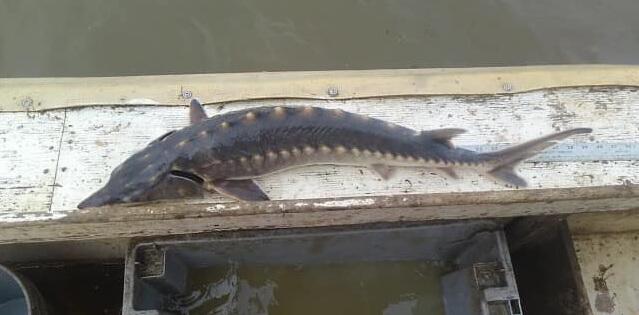
May 5, 2022
VCU researchers tag 2,000th Atlantic sturgeon in the James River
Share this story
Researchers at VCU Rice Rivers Center have tagged their 2,000th Atlantic sturgeon, marking a milestone in the center’s effort to study and support the restoration of the federally endangered fish species that can grow up to 14 feet in length, weigh 800 pounds and live as long as 60 years.
“Never in my wildest dreams did I think we’d get to 2,000 in my time at VCU,” said Matthew Balazik, Ph.D., research assistant professor at VCU Rice Rivers Center, a field station that is part of VCU Life Sciences and devoted to environmental research, teaching and public service. “It took us 11 years to get to 1,000 and then only three years to get to 2,000. It’s a sign that the fish are likely more numerous.”
The 2,000th sturgeon was caught, tagged and released near Westover Plantation in Charles City County, a few miles downstream from the Rice Rivers Center. It was 62 centimeters in length, and genetic testing indicated it was born as part of the James River’s fall sturgeon cohort in 2018.
“The unexpectedly strong presence of Atlantic sturgeon in the James River is a rare example of good news for a federally endangered species. VCU's Rice Rivers Center is pleased to be a contributor of critical conservation research for this iconic coastal species,” said Greg Garman, Ph.D., director of the Rice Rivers Center.
The Rice Rivers Center has been working alongside the U.S. Fish & Wildlife Service, the Virginia Institute of Marine Science, the National Oceanic and Atmospheric Administration, the U.S. Army Corps of Engineers, and the James River Association since 2006 to restore a viable population of Atlantic sturgeon in the James River.
The Atlantic sturgeon is the largest and longest-lived aquatic organism in the Atlantic Slope rivers of North America. They’re believed to have first evolved around 200 million years ago, during the Early Jurassic, and are sometimes referred to as “living dinosaurs.”
Centuries of overfishing, habitat alteration and pollution led to the species’ long decline through most of its historic range. NOAA listed Atlantic sturgeon in the James River as an endangered species under the Endangered Species Act in 2012.
Rice Rivers Center researchers conduct an array of projects focused on the fish in the James, including habitat utilization assessment and restoration, restoration of spawning and nursery habitat, population monitoring, and identification of additional spawning and nursery grounds.
Tagging sturgeon allows researchers to track the fishes’ movements and monitor the population. There are two populations of Atlantic sturgeon that traverse the James, one in the fall and one in the spring. The researchers’ data shows the fall population is very healthy, with adult sturgeon numbering in the thousands. The spring population is not doing as well, with only around 30 fish tagged and researchers finding mostly re-captures when they go out sampling, Balazik said.
Still, he said, hitting the 2,000th sturgeon tagged milestone feels great.
“Back when we first started the program, we were lucky to catch 10 a year. That was back in like 2008. Now we catch hundreds a year,” he said. “And that’s for a fish that supposedly only had 300 adults when it was listed back in 2012. So it’s really cool. It shows that there are more than we thought.”
Subscribe to VCU News
Subscribe to VCU News at newsletter.vcu.edu and receive a selection of stories, videos, photos, news clips and event listings in your inbox.










